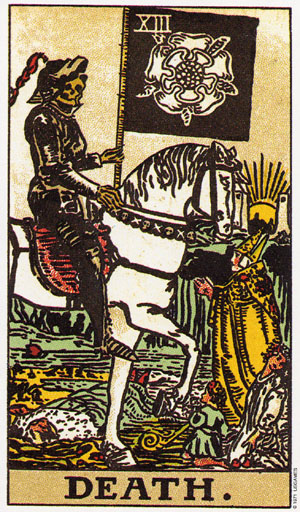Death
Ending, conclusion, transition, passage, departure
Range of meanings
Light: Bringing an unpleasant phase of life to an end. Recognizing and celebrating the conclusion of something. Putting bad habits to rest. Becoming a new person. Leaving one person, place, or thing for another. Letting go.
Shadow: Obsessing on death and dying. Refusing to give up old habits or unhealthy relationships. Insisting that everything and everyone should stay the same forever. Failing to take good care of yourself.
Questions to ask
- What must die in order to make way for new life?
- Which aspects of your situation have persisted over time? Which aspects are temporary?
- Is your own situation just beginning, or is it coming to an end? How can you be sure?
- What needs to end?
- How might an ending actually be a blessing in this situation?
- What’s next?
Advice
Personal Growth: Grasping the short, fleeting nature of life is one of life’s hardest and most sobering lessons. Acknowledging your own impermanence can help you live your life more fully.
Work: Close out lingering projects and tie up loose ends. Now is a good time to consider all your options, including the possibility of moving on. Alternatively, you could put an end to feelings of unrest by deciding, once and for all, to stay put. Do what’s best for you.
Relationships: Identify what’s not working and put it behind you. Take stock, too, of the relationship itself. Dying flames can be rekindled with mutual effort, but embrace an ending if, in fact, an ending is what’s best for you. Sometimes this card can also point to re-invention within a relationship, letting go of our old selves and entering a new chapter of the relationship.
Spirituality: Spiritual scribes write of “dying to the world”—realizing that the physical world and its concerns are illusory at best. For you, the Death card is a reminder to focus on what really matters. Alternatively, the card can suggest a need to contact or honor your ancestors.
Fortune-Telling: A relationship or illness ends suddenly. Limit travel and risk-taking. General gloom and doom.
Associations
Astrological: Scorpio
Hebrew: Nun/Fish/50
Archetype: Death
Religions: Christ in the tomb. Hades. Hypnos. Thanatos. Stories of journeys into the underworld.
Fool's Journey: At the midpoint of the story, the main character believes all is lost. Alternatively, a helper or valued ally dies or is believed dead.
The Number 4: The Status Quo: stability, equality, persistence.
Rose Flag: In The Pictorial Key to the Tarot, Waite writes, “The black banner emblazoned with the Mystic Rose signifies life.” Sometimes something must die in order to make way for the new.
Skeleton: Bones persist long after the decay of the body; so, they are symbols of the enduring and eternal.
Pale Horse: Death's way of getting around. “And I looked, and behold a pale horse: and his name that sat on him was Death” (Revelation 6:8).
Sunset: In many illustrations, it’s difficult to tell whether the sun is rising or setting. The ambiguity of the sun's direction here points to the ambiguous relationship between life and death.
Doomed Figures: The sprawled bodies and scattered body parts seen on many cards reflect death’s disruptive force.
